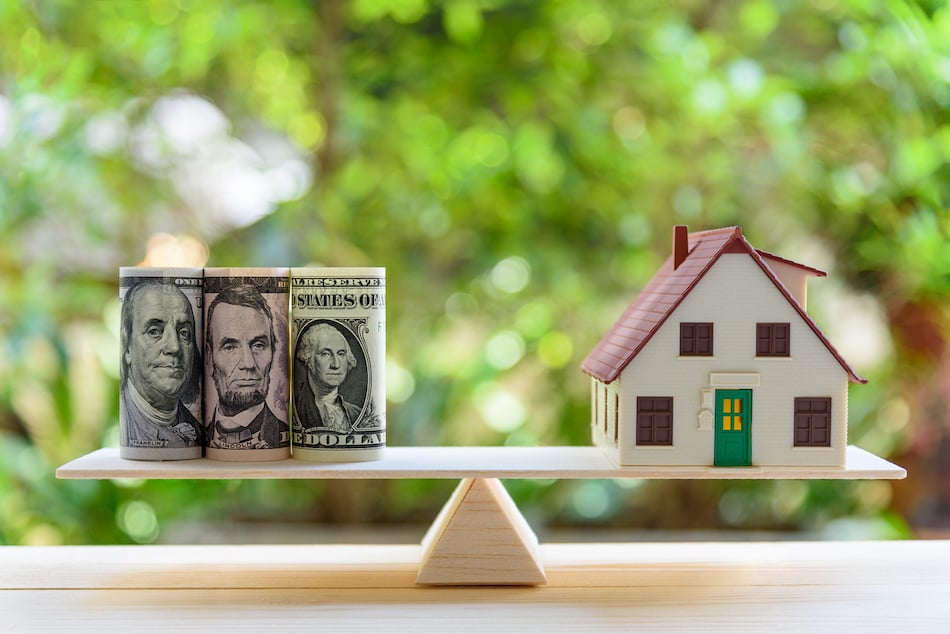Home values in the U.S. have increased by 52% over the past 5 years, according to Zillow (through March 31, 2022), providing buy-and-hold real estate investors with a significant amount of accrued equity.
While one option is to leave home equity alone, other people opt to use a cash-out refinance on their primary residence to buy rental property. Read on if you've been thinking about tapping into your home equity for an investment property.
We’ll explain how to do a cash-out refinance, pros and cons to consider, and alternative ways homeowners can access their equity without refinancing the current loan.
Key takeaways
- A cash-out refinance replaces the current loan with a larger loan, allowing an investor to pull out the difference in cash.
- Funds from a cash-out refi can be used to purchase rental property, creating an additional income stream and the opportunity to claim real estate tax benefits.
- Lenders generally allow a maximum loan-to-value (LTV) of 75% and require a borrower to have a good credit score and a debt-to-income (DTI) ratio of 50% or less.
- The new monthly mortgage payment from a cash-out refinance will be higher, so it's crucial for an investor to crunch the numbers to make sure a new rental property generates sufficient cash flow to offset the increased loan payment.
- Other options for pulling equity out of a property are a home equity loan, a home equity line of credit (HELOC), and a self-directed individual retirement account (SDIRA) for real estate.
How to use a cash-out refinance to buy a rental property
A cash-out refinance is a popular strategy real estate investors use to turn accrued equity into cash to buy a rental property. Equity is accessed by refinancing the existing first mortgage into a larger mortgage to receive the difference in cash.
Here’s an example of how to use a cash-out refi to raise money for a rental property:
- Current property value: $250,000
- Mortgage balance: $100,000
- Equity: $250,000 - $100,000 = $150,000
- Maximum amount of new loan: $250,000 current property value x 75% = $187,500
- Cash available to pull out with refi: $187,500 new loan - $100,000 existing loan payoff = $87,500
Why can’t the entire equity amount of $150,000 be pulled out?
Lenders require a borrower to retain a certain amount of equity with a cash-out refinance, similar to making a down payment on a home. In this example, the borrower has an LTV of 75%, with the remaining 25% or $62,500 kept in the home as equity. However, the maximum LTV for a cash-out refi and other qualifications will vary from lender to lender.
Here are some other guidelines to know about using a cash-out refinance to buy rental property:
- Provide proof of income via pay stubs and tax returns, verify employment, and complete a credit check.
- Have a history of on-time payments with creditors.
- Have a minimum credit score of about 620 or higher.
- Get a new appraisal to verify the current fair market value of the property.
- A DTI of 50% or less is calculated by dividing the monthly mortgage expense by total monthly income.
- Home equity of 25% or more is required so that there is cash to pull out.
- An LTV ratio of 75% or less is calculated by dividing the new mortgage loan amount by the property value.
- A lender may also require a borrower to have up to 6 months, and sometimes more, of cash reserves to pay for monthly mortgage payments.
A lender may also require a minimum seasoning period of at least 6 months from when a home was purchased before closing on a cash-out refinance.
Pros and cons of refinancing to buy a rental property
There are pros and cons to be aware of before doing a cash-out refinance to buy a rental property.
Pros
- You can have a bigger down payment to buy a rental property by combining the cash pulled out with saved money.
- A large down payment may mean better loan terms and a lower interest rate on the rental property.
- If the current loan rate is above market, cash-out refinancing may also mean a lower interest rate on the existing property.
- Lenders generally offer cash-out refinancing loans of 15 or 30 years, with fixed or adjustable interest rates, providing options to match your investment strategy.
- Buying a rental property can also yield tax benefits, such as deducting operating expenses from rental income and claiming depreciation expense to reduce pretax net income.
Cons
- Your monthly mortgage payment will be higher when the new mortgage loan is greater than the current mortgage amount.
- The first home used as collateral may be at risk if higher monthly mortgage payments become difficult to make, causing a borrower to default on the loan.
- Cash-out refinancing also means restarting with a new 30- or 15-year mortgage.
- Closing costs may be higher than alternative funding sources, such as a home equity loan or HELOC.
- Funds from a cash-out refi are received in one lump sum, which may create pressure for an investor to find a rental property fast instead of taking the time to make the right decision.
Alternatives to cash-out refinancing
Using a cash-out refinance to buy rental property isn't always the best option. For example, refinancing to pull cash out may not make good business sense if your new mortgage interest rate would be higher or if you don’t want to restart the clock with another 30-year loan.
Here are 3 alternatives to cash-out refinancing.
Home equity loan
Instead of refinancing the current loan, you could convert accrued equity into cash with a home equity loan. A home equity loan is a second mortgage that uses the equity in a property as collateral.
Generally speaking, lenders will allow 80% of the value of a home to be borrowed from the combined first and second mortgages. For example, if the current fair market value of a home is $250,000 and the outstanding first mortgage balance is $100,000, a borrower could pull out an additional $100,000 with a home equity loan:
- $250,000 home value x 80% = $200,000 - $100,000 first mortgage balance = $100,000
One of the most significant advantages of a home equity loan is that the first mortgage doesn't need to be refinanced. However, you will have 2 mortgage payments because a home equity loan is a second mortgage.
HELOC
A HELOC is similar to having a credit card to access the equity in your home. However, instead of providing cash up front in one lump-sum payment, a HELOC lets you tap into equity and access funds when and if they are needed.
HELOCs generally have a 10-year draw period where you can turn equity into cash, make interest-only payments on the funds borrowed, repay the money borrowed, and borrow again if you wish. Withdrawals cease at the end of the draw period, and monthly repayments of principal and interest (P&I) must be made.
One of the most significant advantages of a HELOC is that interest is only paid when money is borrowed against the equity in your home. The option of making interest-only payments during the draw period also provides the opportunity to stockpile cash from the new property’s rental income until the repayment period begins.
SDIRA
Many investors are pleasantly surprised to learn that retirement savings can be used to buy a rental property while still receiving the tax shelter benefits of an IRA. An SDIRA allows you to invest in a rental property and collect net income and profits tax free by keeping funds within the SDIRA until you begin making withdrawals.
To buy rental property with an SDIRA, you need to set up an account with an IRA custodian or create one yourself, although the rules can be pretty complex. You'll also want to ensure that the rental property held in an SDIRA produces enough cash flow to pay for operating expenses and future capital improvements without having to add additional funds.
One drawback to consider before buying rental property with an SDIRA is that depreciation expenses can't be claimed, which is one of the most significant tax benefits of owning rental property.
Final thoughts
A cash-out refinance is a powerful tool that uses accrued equity in a home to buy rental property. While there are several benefits to a cash-out refi, there are also drawbacks to consider, such as having a higher monthly mortgage payment than your existing mortgage. Before applying for a cash-out refinance to buy a rental property, crunch the numbers to ensure the higher mortgage payment is offset by the income generated by the purchased rental property.










